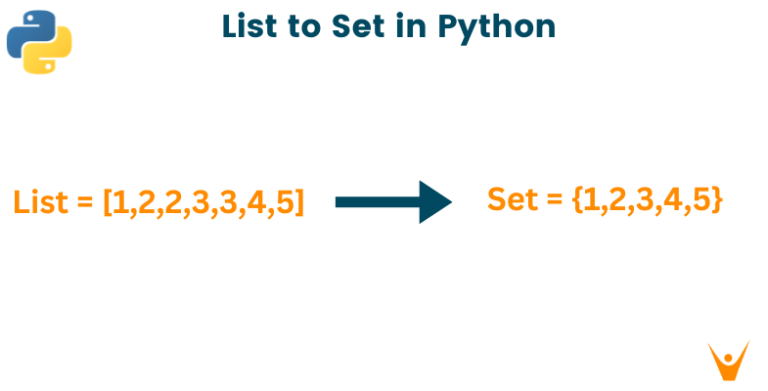Ecommerce Strategies for Selling Wine Online
Embarking on the journey of selling wine online and aspiring to build a prosperous ecommerce platform? You are part of a growing trend. The market for selling wine online is flourishing, underscored by increasing demand, the allure of online convenience, and the vast selection of wines accessible via the internet. A study by Grand View Research revealed that the global market for selling wine online reached USD 9.9 billion in 2020, with an anticipated compound annual growth rate of 9.9% from 2021 to 2028.
However, the path to selling wine online is laden with complexities. To successfully sell wine online, one faces numerous hurdles, such as adhering to legal and regulatory frameworks, managing sourcing and shipping, mastering marketing and branding, and ensuring customer satisfaction. Success in selling wine online demands a clear, well-structured plan and vision.
In this guide, we will share crucial tips, steps, and best practices for starting and scaling your venture in selling wine online. Upon completing this guide, you will have a comprehensive understanding of how to effectively sell wine online and establish a thriving ecommerce business. Let’s embark on this journey!
Step 1: Starting an Online Wine Business
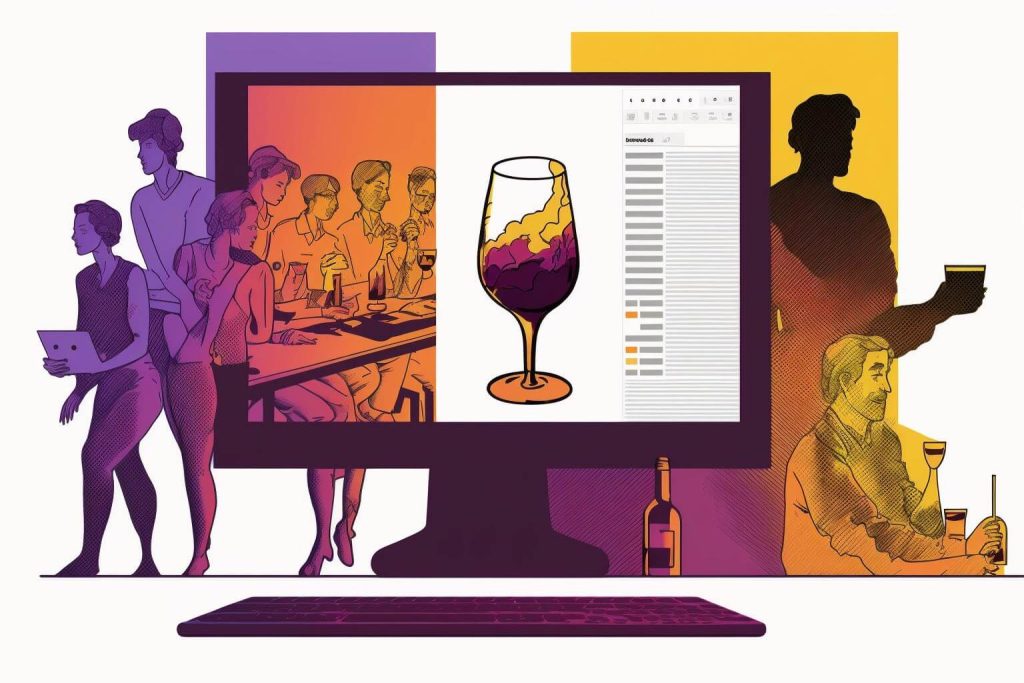
Initiating an online wine business commences with thorough market research. This involves analyzing competitors and understanding the target audience. Such research is pivotal in pinpointing a specific niche, developing a unique selling proposition (USP), and crafting a compelling value proposition for your online wine venture.
Research the Market
The online wine market encompasses a broad and varied landscape, characterized by distinct segments, categories, and evolving trends. Grasping the market’s scope, growth trajectory, potential, and opportunities is crucial, alongside an awareness of its challenges and risks. For comprehensive market analysis, you can employ a range of sources and techniques, including:
- Digital platforms and databases like Statista, IBISWorld, and Wine Intelligence, offering valuable data, analytical reports, and insights on the online wine sector.
- Surveys and interviews, which provide direct feedback, opinions, and preferences from potential customers, suppliers, and industry specialists.
- A SWOT analysis, a strategic tool to assess the strengths, weaknesses, opportunities, and threats relevant to the online wine market and your business within it.
Research the Competitors
The online wine market is a competitive and crowded market, with many players, both big and small, offering similar or different wine products and services. You need to understand who your competitors are, what they offer, how they operate, and how they perform. You can use various sources, tools, and methods to conduct competitor research, such as:
- Online platforms and websites, such as Google, Amazon, and Wine.com, that allow you to search, browse, and compare different online wine stores and products.
- Reviews and ratings, that allow you to read, analyze, and evaluate the feedback, comments, and testimonials from customers and critics.
- Competitive analysis, that helps you compare and contrast the features, benefits, prices, and strategies of your competitors and your online wine business.
Research the Target Audience
The online wine market is characterized by its diversity and segmentation, catering to various customer types, each with unique needs, preferences, and purchasing behaviors. Understanding your target audience is crucial, including their preferences, purchasing habits, and online wine consumption patterns. Utilize a range of sources, tools, and methods for conducting target audience research, such as:
- Online Platforms and Tools: Use resources like Google Analytics, Facebook Insights, and SurveyMonkey to gather and analyze data on your target audience, including demographics, psychographics, and behaviors.
- Personas and Segments: Develop and define personas for your ideal customers, focusing on their characteristics, motivations, and objectives.
- Customer Journey and Value Proposition: Map out the buying process of your target audience, identifying key steps, stages, and touchpoints. This helps in understanding how to deliver value and address their specific problems.
Choose a Niche
In the bussiness of selling wine online, utilizing research on market trends, competitor activities, and target audience preferences, you can pinpoint and select a niche for your online wine business. A niche represents a distinct and focused market segment with unique demands, tastes, and challenges. By targeting a specific niche, your online wine business can stand out from competitors and draw in a dedicated, profitable customer base. Niche options in the online wine market include:
- Vintage wine, specializing in the sale of rare, aged, and collectible wines.
- Premium wine, focusing on high-end, costly, and exclusive wine selections.
- Organic wine, dedicated to offering natural, environmentally-friendly, and health-conscious wine choices.
Choose a Unique Selling Proposition (USP)
Based on your niche, you can choose a unique selling proposition (USP) for your online wine business. A USP is a statement that summarizes what makes your online wine business different, better, and special than your competitors, and why customers should buy from you. A USP can help you communicate your value and benefits to your target audience, and persuade them to choose you over your competitors. Some examples of USPs in the online wine market are:
- The largest and most diverse selection of wine products online.
- The fastest and most reliable delivery of wine products online.
- The most personalized and customized service of wine products online.
Step 2: Building an Online Wine Store
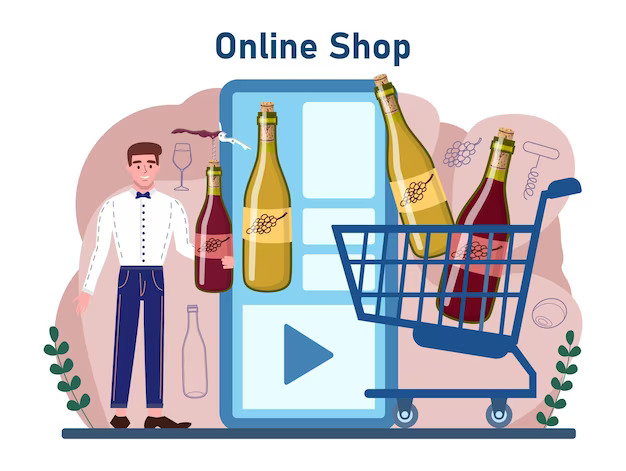
The next crucial step in starting an online wine business is developing a website or app for selling wine online. This platform is essential for showcasing products, processing orders, and managing operations. An effective online wine store should be user-friendly, visually appealing, and functional, ensuring an excellent customer experience and high conversion rates.
Choose a Platform
There are many options, platforms, and services available for selling wine online, such as:
- Shopify: A popular, user-friendly ecommerce platform that enables easy creation and customization of your online wine store without requiring coding skills. Shopify provides features for inventory management, payment processing, marketing, and analytics, supporting the growth and management of your online wine business.
- WooCommerce: A robust ecommerce plugin transforming a WordPress website into a fully customizable online wine store. It offers comprehensive features for product catalog management, shopping cart, checkout, shipping, and security.
- WineDirect: A dedicated ecommerce platform tailored for the wine industry, allowing the creation and customization of a specialized online wine store. WineDirect features wine club management, loyalty programs, compliance solutions, and CRM tools.
Design Your Online Wine Store
After selecting your platform, the next step is to design your online wine store, ensuring it’s attractive, coherent, and professional. Key design aspects to consider include:
- Layout: This refers to how elements like the header, footer, sidebar, and menu are arranged in your online store. A clear, logical layout guides customers smoothly through your site, helping them easily locate what they need.
- Navigation: The design of links, buttons, and categories within your store should be straightforward and user-friendly. This simple navigation system allows customers to effortlessly access various pages and features of your wine store.
- Product Pages: These are crucial for showcasing your wines. Each page should include the wine’s name, image, price, description, and rating. Informative and appealing product pages are key to attracting customers and encouraging purchases.
- Checkout Process: A smooth and secure checkout experience is essential. This process, which includes entering personal, shipping, and payment information, should be quick and hassle-free to minimize cart abandonment.
To achieve these design goals, you can utilize the templates, themes, and plugins your platform offers or consider hiring a professional web designer for a more customized approach.
Optimize Your Online Wine Store
Once you have designed your online wine store, the next crucial phase is optimization to enhance visibility, accessibility, and effectiveness. Consider these key optimization elements:
- SEO (Search Engine Optimization): This involves improving your store’s ranking on search engines like Google, Bing, and Yahoo. Implement various SEO strategies such as keyword usage, effective headings, and incorporating images, videos, and reviews. These tactics aim to optimize your content, structure, and site speed, thereby increasing organic traffic.
- User Experience: Focus on how customers perceive and react to your online store. Work on enhancing usability, functionality, accessibility, and aesthetics to create a positive user experience.
- Customer Satisfaction: Gauge and improve your customers’ satisfaction and loyalty towards your online store, products, and services. Monitor metrics like feedback, ratings, reviews, retention rates, and referrals to enhance your store’s quality, value, and reputation, ultimately boosting customer satisfaction and loyalty.
Utilize the features, tools, and integrations your platform offers or consider hiring a professional web developer for advanced optimization of your online wine store.
Learn more:
Professional Website Design And Development Agencies
How To Choose The Right SEO Providers For Your Digital Success
Step 3: Sourcing and Shipping Wine Online
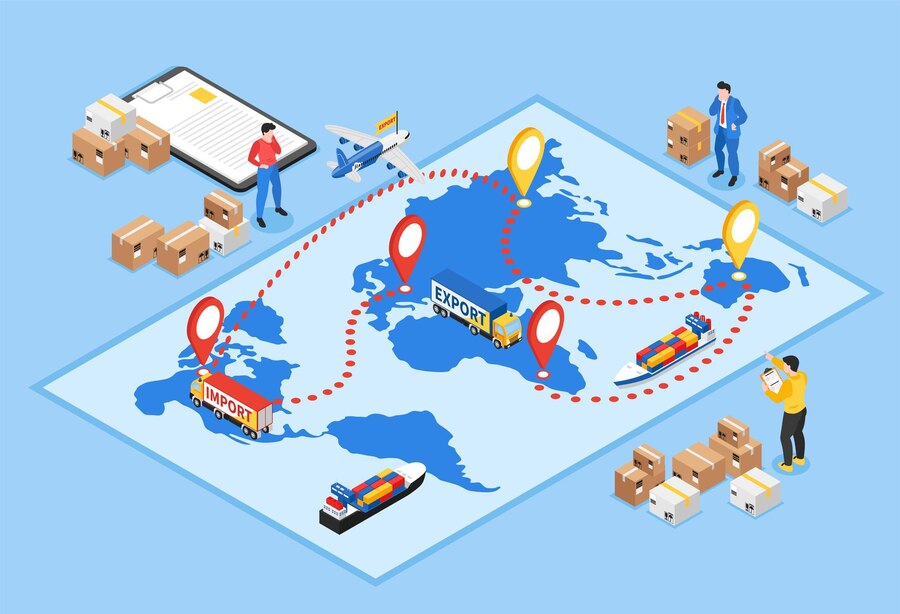
The third critical step in establishing an online wine business involves sourcing and shipping wine products to your customers. This phase is essential for ensuring product availability, order fulfillment, and inventory management. It’s important to establish a sourcing and shipping system that is reliable, efficient, and compliant, guaranteeing the quality, safety, and customer satisfaction of your wine products.
Source Wine Products
There are many options, sources, and suppliers available for obtaining wine products, such as:
- Local Wineries: As the primary producers and manufacturers, local wineries provide fresh, authentic, and exclusive wine products. They also offer the opportunity for direct relationships and partnerships.
- Distributors: Serving as intermediaries, distributors offer a broad selection of wines from various wineries, regions, and countries. They often provide bulk purchasing options and discounted pricing.
- Wholesalers: Retailers and resellers of wine products, wholesalers offer a diverse range of wines from different distributors, brands, and categories. They provide flexible ordering and delivery options.
Select a source that aligns with your business needs, budget, and preferences. Establishing and maintaining a strong, long-term relationship with your supplier is key to the success of your online wine business.
Ship Wine Products
There are many options, methods, and services available for shipping wine products to customers, such as:
- Couriers: Companies like FedEx, and UPS specialize in wine product delivery. They offer fast, reliable, and secure shipping, along with additional features like tracking, insurance, and signature options.
- General Carriers: Firms such as USPS provide general delivery services. They offer cost-effective, standard, and priority shipping for wine products, also including tracking, insurance, and signature options.
- Fulfillment Centers: Facilities like Amazon FBA handle storage, packing, and shipping. They provide hassle-free, automated, and scalable shipping solutions, along with inventory management, customer service, and return handling.
Choose a shipping method that aligns with your business needs, budget, and preferences, and adhere to the instructions and guidelines of the chosen service.
Comply with Laws and Regulations
One critical and intricate aspect of selling and shipping wine online involves adherence to the wine industry’s legal framework. This encompasses:
- Licenses, Permits, and Certifications: These are essential legal documents that authorize the online sale and shipment of wine. They include federal, state, and local licenses, permits, and certifications, which vary based on location, business model, and product category.
- Taxes and Fees: These are the financial obligations associated with online wine sales and shipments. This category includes federal, state, and local taxes and fees, which also vary depending on location, business structure, and product type.
- Compliance: This refers to the process of abiding by industry laws and regulations. Key compliance areas include age verification, label approval, volume limits, reporting, and record-keeping. These requirements differ based on your location, business type, and product category.
It’s essential to conduct thorough research, understand, and comply with these regulations. Consulting with a professional lawyer, accountant, or consultant is advisable to ensure that your online wine business operates legally, ethically, and in full compliance.
Step 4: Marketing and Growing an Online Wine Business
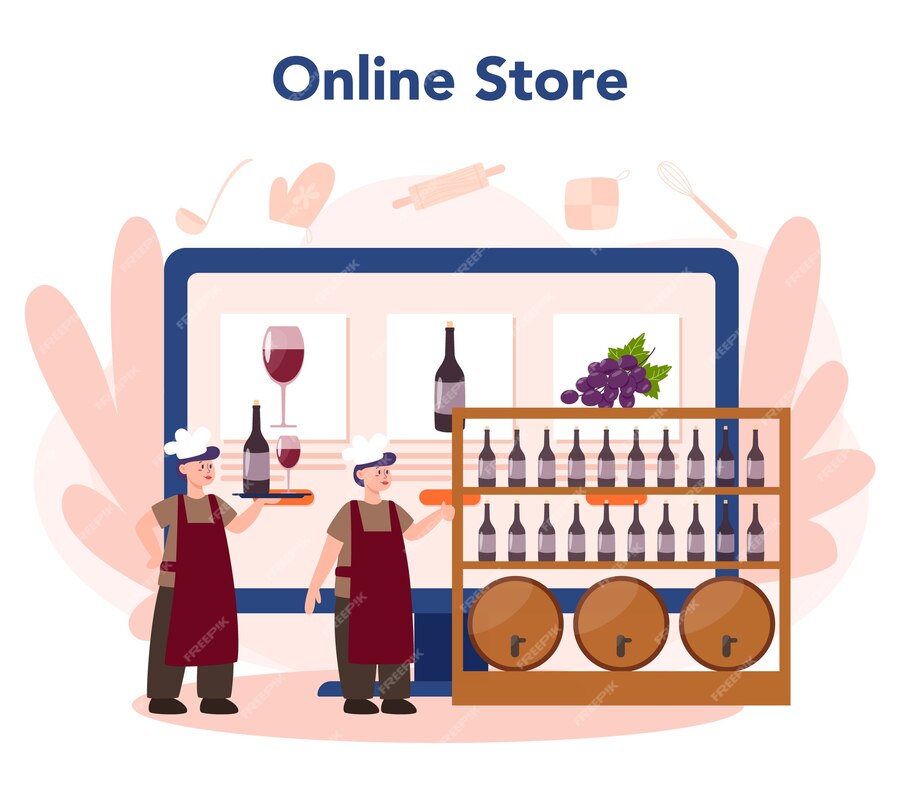
The final step in establishing an online wine business involves the promotion and expansion of your online store and brand. This is crucial for enhancing visibility, building brand awareness, and establishing credibility. It also plays a significant role in attracting and retaining a larger customer base and increasing sales. An innovative, efficient, and consistent marketing and growth strategy is necessary. This strategy should highlight your unique value and benefits, setting your online wine business apart from competitors.
Choose a Channel
A variety of channels and strategies are available for marketing and expanding an online wine business, including:
- Social Media: Platforms like Facebook, Instagram, and Twitter facilitate connection and communication with your target audience. These platforms can enhance your reach, engagement, and loyalty while allowing you to share content, stories, and offers.
- Email: Tools like Mailchimp enable sending and receiving messages to and from your target audience. Email marketing can boost conversions, retention, and referrals, and is effective for distributing newsletters, promotions, and updates.
- Content: Various forms of online content, including blogs, videos, and podcasts, serve to educate and entertain your target audience. This can improve your website traffic, establish authority, and build reputation, providing value, tips, and insights.
- Influencers: Individuals like bloggers, vloggers, and celebrities, who possess significant online following and influence, can enhance your product’s exposure, build trust, and encourage advocacy, effectively endorsing your products, services, and brand.
Select the channel that aligns with your business needs, budget, and preferences, and develop a marketing and growth strategy that meets your goals, objectives, and performance metrics.
Measure and Improve
After selecting your marketing channel, the next step is to assess and enhance your marketing and growth efforts. This can be achieved through:
- Analytics: Utilize online tools like Google Analytics to collect, monitor, and analyze data related to your marketing activities. These tools assist in measuring and tracking key performance indicators (KPIs) such as traffic, conversions, and sales.
- Feedback: Employ online methods like surveys, reviews, and ratings to gather and address customer opinions and suggestions. This approach aids in evaluating and improving customer satisfaction, loyalty, and retention.
- Testing: Implement techniques like A/B testing to compare different aspects of your marketing elements. This method helps in optimizing user experience, conversion rate, and revenue.
Make use of the features, tools, and integrations your platform offers, or consider hiring a professional marketer, to effectively measure and improve your marketing and growth performance.
Conclusion
Selling wine online presents a promising avenue for establishing a successful ecommerce business. It offers numerous benefits, including access to a broader audience, increased sales potential, and a diverse product range. However, selling wine online requires meticulous planning, thorough preparation, and strategic execution. This business model comes with its set of challenges, complexities, and regulatory requirements, such as efficient sourcing and shipping, impactful marketing and branding, and ensuring customer service and satisfaction.
For assistance in building and managing your online wine business, consider partnering with OnextDigital. We specialize in web development, UX/UI design, and white label software services, capable of creating, designing, and optimizing your online wine store. Additionally, we provide tailored and scalable solutions to meet your business needs. For more information, visit our website or reach out via email. OnextDigital stands as a reliable ally in your journey to establish a thriving online wine business. Contact Us today.


